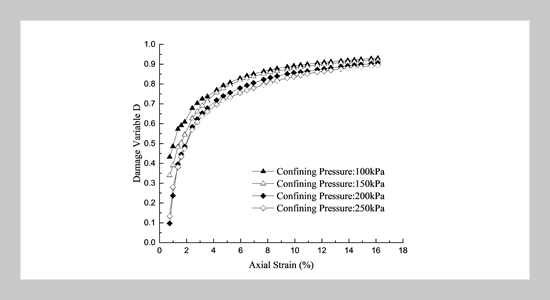REFERENCES
- [1] Shen, Z. J., “An elasto-plastic damage model for cemented clays,” Chinese Journal of Geotechnical Engineering, Vol. 15, No. 03, pp. 21-28 (2007).
- [2] Shen, Z.J., “A nonlinear damage model for structured clay,” Hydro-Science and Engineering, Vol. 03, pp. 247-555 (1993). doi: 0.16198/j.cnki.1009-640x.2002.04.002
- [3] He, K.S., Shen, Z.J., “Elasto-viscoplastic damage model for structural clays,” Hydro-Science and Engineering, Vol. 04, pp. 7-13 (2002).
- [4] Cheng, Z., She, Z.J., and Chen T.L., “A bounding surface masonry model for structured clays,” Rock and Soil Mechanics, Vol. 24, No. 3, pp. 317-320 (2003). doi: 10.13243/j.cnki.slxb.2004.01.016
- [5] Wang, L.Z., Zhao, Z.Y, and Li, L.L., “Non-linear elastic model considering soil structural damage,” Shuili Xuebao, Vol. 1, pp. 83-89 (2004).
- [6] Zhang, B.Y., Soil constitutive model based on structured soil. Master thesis, Dalian University of Technology, Dalian (2006).
- [7] Xia, W.M., The elasto-plastic damage constitutive model of loess and its engineering application. Ph.D. Dissertation, Xi’an University of Technology, Xi’an (2005).
- [8] Wang, Y., Research on the viscoelastic-viscoplastic-damage model of structural soft soil. Ph.D. Dissertation, Wuhan university of technology, Wuhan (2006).
- [9] Jiang, C.L., Study on structure damage and evolution of loess. Ph.D. Dissertation, Northweat A&F University, Xianyang (2008).
- [10] Chen, M. S., Wang, S.J., Mao, X. and et al, “Fissure morphology and mechanical characterization for structure-damaged expansive soil under triaxial compression tests,” Chinese Journal of Geotechnical Engineering, Vol. 38, No. S2, pp. 73-78.
- [11] Xiong, C.F., Cao, Y., “Analysis on the influencing factor of structure damage of marine soft clay,” Journal of Wuhan university of technology, Vol. 35, No. 11, pp. 90-93 (2013).
- [12] Zhang, T.W., Xu, H.B., Deng, Y.F. “A study of the correlation between the damage index and disturbance degree of structural soft clay,” Rock and Soil Mechanics, Vol. 36, No. 04, pp. 958-964 (2015). doi:10.16285/j.rsm.2015.04.007
- [13] Chen, X.J., Huang, X, Shao, H.B and Qi, Y.L. “Study on the shear strength characteristics of the remolded laterite soil in Guilin,” Unsaturated Soil Mechanics-from theory to practice: Proceedings of 6th Asia Pacific conference on unsaturated soil, Guilin, China, October 23-26,2 015.
- [14] Chen, X.J., Li, J.C., Song Y., Bai H.Y. “Effect of nano graphite powder on mechanical properties of red clay” Journal of Engineering Geology, Vol.26, No. 01, pp.97-102 (2018). doi: 10.13544/j.cnki.jeg.2018.01.011
- [15] Chen, X.J., Hu, S.W., Huang, Y.Y., Bai, H.Y., “Experimental study on strength characteristic of red clay under influence of nano-CaCO3” Journal of Engineering Geology, Vol.5, pp. 1293-1298. (2017). doi: 10.13544/j.cnki.jeg.2017.05.015.
- [16] Kondner, R.L., “Hyperbolic stress-strain response: cohesive soils,” Journal of the Soil Mechanics and Foundations Division, Vol. 89, No. SM1, pp. ll5-143 (1963). doi: 10.1016/0022-4898(64)90153-3
- [17] Zhang, Y., Kong, L.W., Meng Q.S. and et al., “Normalized stress-strain behavior of Wuhan soft clay” Rock and Soil Mechanics, Vol. 27, No.9, pp. 1509-1513 (2006). doi: 10.16285/j.rsm.2006.09.015
- [18] Zhao, X.H., Sun H., Luo G.W., Damage soil Mechanics. Tongji University Press, Shanghai, pp 19-21 (2002).
- [19] Lin, B., Research on rheological model of loess in considering of damage effect. Ph.D. Dissertation, Chang’an University (2005).









